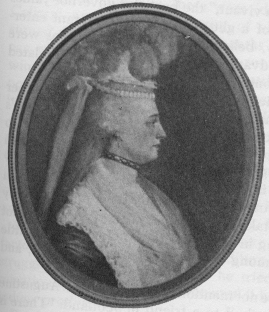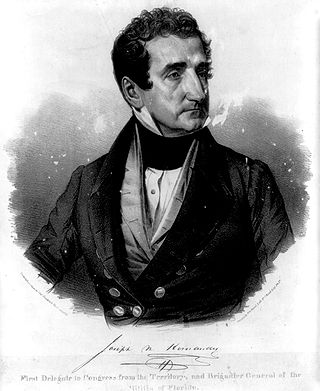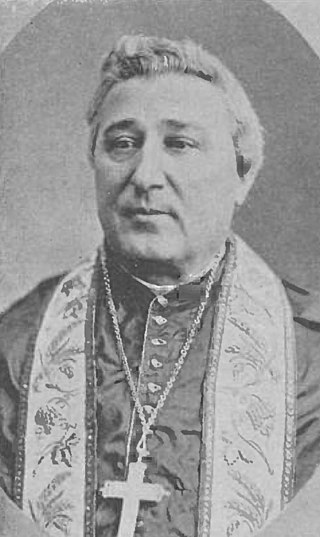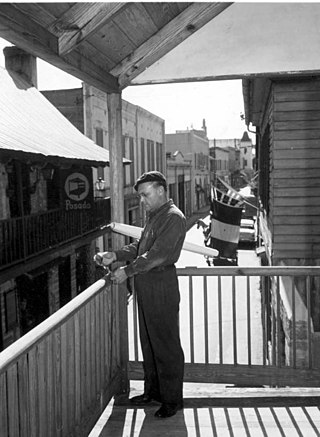Related Research Articles

St. Augustine is a city in and the county seat of St. Johns County located 40 miles south of downtown Jacksonville. The city is on the Atlantic coast of northeastern Florida. Founded in 1565 by Spanish explorers, it is the oldest continuously inhabited European-established settlement in what is now the contiguous United States.

New Smyrna Beach is a city in Volusia County, Florida, United States, located on the central east coast of the state, with the Atlantic Ocean to the east. The downtown section of the city is located on the west side of the Indian River and the Indian River Lagoon system. The Coronado Beach Bridge crosses the Intracoastal Waterway just south of Ponce de Leon Inlet, connecting the mainland with the beach on the coastal barrier island. Its population is 30,142 in 2020 by the United States Census Bureau.

El Camino Real is the name that the Spanish gave to a trail they cleared in the 1680s, mostly over the traditional trails of Native Americans, from St. Augustine westward to the Spanish missions in north Florida. Before this time, transpeninsular traffic in La Florida between the western mission settlements and the capital depended on water routes from Apalachee to St. Augustine. Agricultural commodities produced in Apalachee were carried by canoes to the Gulf of Mexico and southward on the coast to the mouth of the Suwanee River, then upriver to a location on the Santa Fe River. There they were loaded onto pack animals or the backs of Indian burderners (porters) for the remainder of the overland trip. Provisions and funds from the real situado were sent on the same route in reverse.

Patrick Tonyn (1725–1804) was a British General who served as the last British governor of East Florida, from 1774 to 1783. His governorship lasted the span of the American Revolution. East Florida was a Loyalist colony during the war.

Gracia Maria Robin was the daughter of a wealthy French merchant, Jean Baptiste Robin, in Smyrna, Ottoman Empire, in what is now Turkey. Her name has erroneously been recorded in places as Dura Bin, a mis-transcription of 'du Robin'. She married Dr. Andrew Turnbull, a former British Consul at Smyrna, who organized the largest attempt at British colonization in the New World by founding New Smyrna, Florida, named in honor of Gracia's birthplace. New Smyrna, Florida Colony, founded in 1768, encompassed some 101,400 acres (410 km2).
Andrew Turnbull was a Scottish physician and diplomat who served as the British consul at Smyrna, Ottoman Empire. In 1768, he founded the colony of New Smyrna, Florida, named in honor of his wife's birthplace, the ancient Greek city of Smyrna on the Aegean coast of Anatolia. Turnbull was married to Gracia Dura Bin, the daughter of a Greek merchant from Smyrna. His colony was located in the province of British East Florida, and encompassed some 101,400 acres (410 km2); it was nearly three times the size of the colony at Jamestown.

Joseph Marion Hernández was a slave-owning American planter, politician and military officer. He was the first delegate from the Florida Territory and the first Hispanic American to serve in the United States Congress. A member of the Democratic-Republican Party, he served from September 1822 to March 1823.

The Avero House is a historic house located at 41 St. George Street in St. Augustine, Florida, United States. The building is locally significant as one of 30 remaining houses within the historic district that pre-date 1821. It was once the site of a Minorcan Chapel. Today, the building is home to the St. Photios Greek Orthodox National Shrine.

The datil is a very hot pepper, a variety of the species Capsicum chinense.

Anthony Dominic Pellicer was an American prelate of the Catholic Church. He was the first Bishop of San Antonio, serving from 1874 until his death in 1880.

Albert C. Manucy was an author, historian and a Fulbright Scholar who specialized in Spanish Colonial Florida and the architecture of St. Augustine, Florida.

Tolomato Cemetery is a Catholic cemetery located on Cordova Street in St. Augustine, Florida. The cemetery was the former site of "Tolomato", a village of Guale Indian converts to Christianity and the Franciscan friars who ministered to them. The site of the village and Franciscan mission is noted on a 1737 map of St. Augustine. A cemetery for the inhabitants of the village was also located on the grounds, with a portion of this cemetery set aside for former American black slaves, who had converted to Catholicism after escaping bondage in the Carolinas.
Robert James Turnbull was an American lawyer, planter, writer and politician from South Carolina who also published under the name Brutus. His essays in the Charleston Mercury advocating nullification were published as a pamphlet under the title The Crisis: Or, Essays on the Usurpations of the Federal Government, which has been described as "the handbook for nullification and resistance."
Francisco Pellicer ( c1747-1826) was an early resident and carpenter of colonial St. Augustine, Florida. He was named a Great Floridian in 2000, and Pellicer Creek is named in his honor.
The King's Road was a road built by the British in their colony of East Florida. It stretched from the St. Marys River, the border between East Florida and Georgia, to south of New Smyrna, and was mostly completed by 1773.
Antonia Paula de la Resurreccion Bonelly (1786-1870), was a colonial woman of Spanish East Florida who was captured by Miccosukee Indians in 1802 and held captive for twenty-two months. Her rescue and ransom involved many of the major power players that defined relations in this period between the Florida tribes and the nations of Britain, Spain, and the United States.

Carita Doggett Corse was a Florida historian and writer who served as the Florida director of the Federal Writers’ Project. Her most well-known books are Dr. Andrew Turnbull and the New Smyrna Colony of Florida and The Key to the Golden Islands. Corse, an early suffragette, became the director of Florida's chapter of the newly created Planned Parenthood. In 1978, she was recognized for her work as an historian by the Florida Historical Society, and, in 1997, was posthumously inducted into the Florida Women's Hall of Fame, an honor roll recognizing women who have "made significant contributions to the improvement of life for women and all Florida citizens."

The William Watson House is located at 206 Charlotte Street in St. Augustine, Florida. It is a reconstructed property representing the architecture of St. Augustine's British Period (1763-1784).

The Triay House is a historic property located at 31 St. George Street in St. Augustine, Florida. It is a reconstruction of the First Spanish Period structure that stood on the site.

The Pellicer-De Burgo House is located at 53 St. George Street in St. Augustine, Florida. It is a reconstruction of two connected houses built during the British Period (1763-1783) of East Florida.
References
- 1 2 3 4 5 6 "Upwardly Mobile Minorcans and Florida's First Beachside Development". www.unf.edu.
- 1 2 3 4 "History of Minorcans in Florida". sites.rootsweb.com.
- 1 2 3 "Minorcans of St. Augustine | Southern Foodways Alliance – Southern Foodways Alliance". July 20, 2015.
- ↑ "Richard Grenville, the Earl of Temple – Florida History Online".
- 1 2 "Origin and demise". www.volusia.org. February 25, 2016.
- ↑ Staff Writer. "Minorcans date to 1800s here". St. Augustine Record.
- ↑ Kotlik, George (August 27, 2020). "Minorcans, New Smyrna, and the American Revolution in East Florida". Journal of the American Revolution.
- ↑ Augustine, Mailing Address: 1 South Castillo Drive Saint; Us, FL 32084 Phone: 904 829-6506 Contact. "The Menorcans – Castillo de San Marcos National Monument (U.S. National Park Service)". www.nps.gov.
{{cite web}}: CS1 maint: numeric names: authors list (link) - 1 2 Masters, Jeremy. "HOME".
- ↑ "Florida Memory • Minorcans".
- ↑ Griffin, Patricia C. (December 24, 2016). Mullet on the Beach: The Minorcans of Florida, 1768–1788 – Patricia C. Griffin – Google Books. ISBN 9780813010748.
- 1 2 Soergel, Matt. "Minorcans of Northeast Florida maintaining identity through generations". The Florida Times-Union.
- ↑ "The Minorcan Heritage Historical Marker". www.hmdb.org.
- ↑ Willis, Priscilla (April 25, 2020). "Food and Culture: Minorcan Clam Chowder in St. Augustine, Florida".
- ↑ "DINING FLORIDA'S MELTING POT IS A BIG, ETHNIC STEW INDIAN, SPANISH, GREEK, CUBAN, MINORCAN, SOUTHERN INFLUENCES COMBINE TO GIVE OUR CUISINE A DELICIOUS AND VARIED TASTE". Orlando Sentinel. 29 October 1989.
- ↑ Foertsch, Jacqueline (2007). ""Extraordinarily Convenient Neighbors": African-American Characters in White-Authored Post-Atomic Novels". Journal of Modern Literature. 30 (4): 122–138. doi:10.2979/JML.2007.30.4.122. JSTOR 30053149. S2CID 162268412 – via JSTOR.
- ↑ "Alas, Babylon by Pat Frank, from Project Gutenberg Canada". gutenberg.ca.
- ↑ Yerty, Kim (January 11, 2023). "Menorcan Heritage Celebration".
- ↑ Gardner, Sheldon. "Menorcans celebrate rich history". St. Augustine Record.